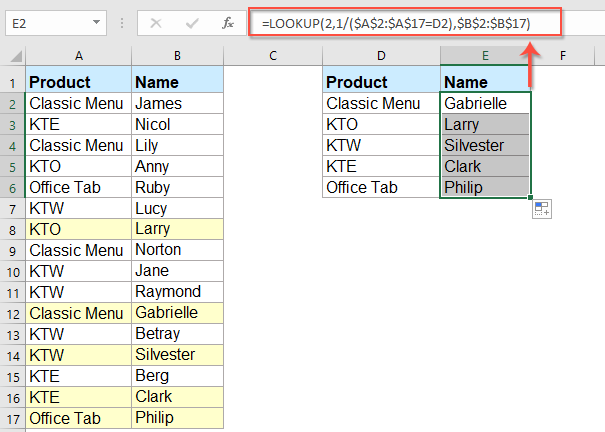如何在 Excel 中從下往上進行 VLOOKUP 匹配值?
Excel 的 VLOOKUP 函數通常從上到下搜索,返回它遇到的第一個匹配值。然而,在某些情況下,您可能需要從下往上搜索。由於 VLOOKUP 缺乏內置的反向搜索功能,因此需要替代方法來實現這一目標。
在 Excel 中從下往上 Vlookup 最後一個匹配值
使用 LOOKUP 函數從下往上 Vlookup 最後一個匹配值
要從下往上 Vlookup 匹配值,以下 LOOKUP 公式可以幫助您,請按照以下步驟操作:
請在想要獲取結果的空白單元格中輸入以下公式:
=LOOKUP(2,1/($A$2:$A$17=D2),$B$2:$B$17)然後將填充手柄向下拖動到您想獲取結果的單元格,最後對應的值將立即返回,請參見截圖:

- $A$2:$A$17=D2:這部分檢查 A2:A17 範圍內哪些單元格等於 D2 單元格中的值。它返回一個 TRUE(如果條件滿足)或 FALSE(如果不滿足)的數組。
- 1/($A$2:$A$17=D2):這將 TRUE/FALSE 數組轉換為 1(對於 TRUE)和 #DIV/0!錯誤(對於 FALSE),因為用 1 除以 TRUE 得到 1,而用 0 除以 FALSE(即 0)會導致錯誤。
- LOOKUP(2, ...):LOOKUP 函數在步驟 2 中創建的數組中搜索值 2。由於 2 大於數組中的任何 1,因此它匹配最後一個 1(即條件最後一次滿足的地方)。
- $B$2:$B$17:這是返回相應值的範圍。該函數返回 B2:B17 中與步驟 3 中找到的最後一個 1 對應的值。
使用 Kutools for Excel 從下往上 Vlookup 最後一個匹配值
幸運的是,Kutools for Excel 使用其強大的“從下到上查找”功能簡化了這一過程。此工具允許您快速查找並返回列表中的最後一個匹配值,而無需複雜的公式。
安裝 Kutools for Excel 後,請按以下步驟操作:
1. 點擊 “Kutools” > “高級 LOOKUP” > “從下到上查找”,請參見截圖:

2. 在“從下到上查找”對話框中,執行以下操作:
- 從“輸出區域”和“查找值”部分選擇查找值單元格和輸出單元格;
- 然後,從“資料區域”部分指定相應的項目。
- 最後,點擊“確定”按鈕。

3. 所有最後的匹配值將立即返回,請參見截圖:

如果您想用其他文本值替換 #N/A 錯誤值,只需點擊“選項”按鈕並勾選“用指定值替換未找到的值(#N/A)”選項,然後輸入所需的文本即可。 
使用 XLOOKUP 函數從下往上 Vlookup 最後一個匹配值
XLOOKUP 函數是 VLOOKUP 和 HLOOKUP 的現代替代品。它簡化了查找最後一個匹配值的過程。
在空白單元格中輸入以下公式,然後將填充手柄向下拖動到單元格以獲取最後的對應值,如下所示:
=XLOOKUP(D2, $A$2:$A$17, $B$2:$B$17, , , -1)
- D2:要查找的值。
- $A$2:$A$17:查找範圍。
- $B$2:$B$17:返回範圍。
- -1:從最後一個值搜索到第一個值(從下到上)。
結論
- 如果您使用的是 Excel 365/2021 或更高版本,XLOOKUP 函數是查找最後一個匹配值最有效且直接的方法。
- 對於較舊版本的 Excel,LOOKUP 函數是一個可靠的替代方案,儘管它需要更多對數組邏輯的理解。
- 如果您偏好用戶友好、無公式的解決方案,Kutools for Excel 是一個不錯的選擇,不過它作為第三方外掛程式需要一定的成本。
通過這些方法,您可以高效地從下往上進行 VLOOKUP 並找到數據集中的最後一個匹配值。如果您對探索更多 Excel 技巧感興趣,我們的網站提供了數千個教程,幫助您掌握 Excel。
更多相關文章:
- 跨多個工作表 Vlookup 值
- 在 Excel 中,我們可以輕鬆應用 vlookup 函數返回單個工作表表格中的匹配值。但是,您是否考慮過如何跨多個工作表進行 vlookup 值?假設我有以下三個帶有數據範圍的工作表,現在我想根據這些三個工作表中的條件獲取部分對應值。
- 在 Excel 中使用 Vlookup 精確匹配和近似匹配
- 在 Excel 中,vlookup 是我們最重要的函數之一,用於搜索表格左側列中的值並返回該範圍同一行的值。但是,您是否成功應用 vlookup 函數?本文將介紹如何在 Excel 中使用 vlookup 函數。
- Vlookup 返回空白或其他特定值而不是 0 或 N/A
- 通常,當您應用 vlookup 函數返回相應值時,如果您的匹配單元格為空白,則會返回 0,如果找不到匹配值,則會得到錯誤 #N/A 值,如下面的屏幕截圖所示。除了顯示 0 或 #N/A 值之外,如何讓它顯示空白單元格或其他特定文本值?
- Vlookup 並返回匹配值的整行數據
- 通常,您可以使用 Vlookup 函數從數據範圍中查找並返回匹配值,但您是否嘗試過根據特定條件查找並返回整行數據,如以下屏幕截圖所示。
- Vlookup 並連接多個相應值
- 眾所周知,Excel 中的 Vlookup 函數可以幫助我們查找值並返回另一列中的相應數據,但一般來說,如果有多個匹配數據,它只能獲取第一個相關值。本文將討論如何在單一單元格或垂直列表中 vlookup 並連接多個相應值。
最佳 Office 生產力工具
| 🤖 | Kutools AI 助手:以智能執行為基礎,革新數據分析 |生成程式碼 | 創建自訂公式 | 分析數據並生成圖表 | 調用 Kutools 增強函數… |
| 熱門功能:查找、選取項目的背景色或標記重複值 | 刪除空行 | 合併列或單元格且不遺失數據 | 四捨五入(免公式)... | |
| 高級 LOOKUP:多條件 VLookup|多值 VLookup|多表查找|模糊查找... | |
| 高級下拉列表:快速創建下拉列表 |依賴型下拉列表 | 多選下拉列表... | |
| 列管理器:添加指定數量的列 | 移動列 | 切換隱藏列的顯示狀態 | 比較區域及列... | |
| 精選功能:網格聚焦 | 設計檢視 | 增強編輯欄 | 工作簿及工作表管理器 | 資源庫(快捷文本) | 日期提取器 | 合併資料 | 加密/解密儲存格 | 按列表發送電子郵件 | 超級篩選 | 特殊篩選(篩選粗體/傾斜/刪除線...)... | |
| 15 大工具集:12 項文本工具(添加文本、刪除特定字符…)|50+ 儀表 類型(甘特圖等)|40+ 實用 公式(基於生日計算年齡等)|19 項插入工具(插入QR码、根據路徑插入圖片等)|12 項轉換工具(金額轉大寫、匯率轉換等)|7 項合併與分割工具(高級合併行、分割儲存格等)|...及更多 |
運用 Kutools for Excel,全面提升您的 Excel 技能,體驗前所未有的高效。 Kutools for Excel 提供超過300 項進階功能,讓您提升工作效率、節省時間。 點此尋找您最需要的功能...
Office Tab 為 Office 帶來分頁介面,讓您的工作更加輕鬆簡單
- 在 Word、Excel、PowerPoint 中啟用分頁編輯與閱讀。
- 在同一視窗的新分頁中打開與創建多份文件,而非開啟新視窗。
- 提升您的生產力50%,每日可幫您減少數百次鼠標點擊!
所有 Kutools 外掛,一次安裝
Kutools for Office 套裝整合了 Excel、Word、Outlook 和 PowerPoint 的外掛,外加 Office Tab Pro,非常適合需要跨 Office 應用程式協同作業的團隊。
- 全合一套裝 — Excel、Word、Outlook及 PowerPoint 外掛 + Office Tab Pro
- 一鍵安裝,一份授權 — 幾分鐘完成設置(支援 MSI)
- 協同運作更順暢 — Office 應用間無縫提升生產力
- 30 天全功能試用 — 無需註冊、無需信用卡
- 最超值 — 一次購買,節省單獨外掛費用